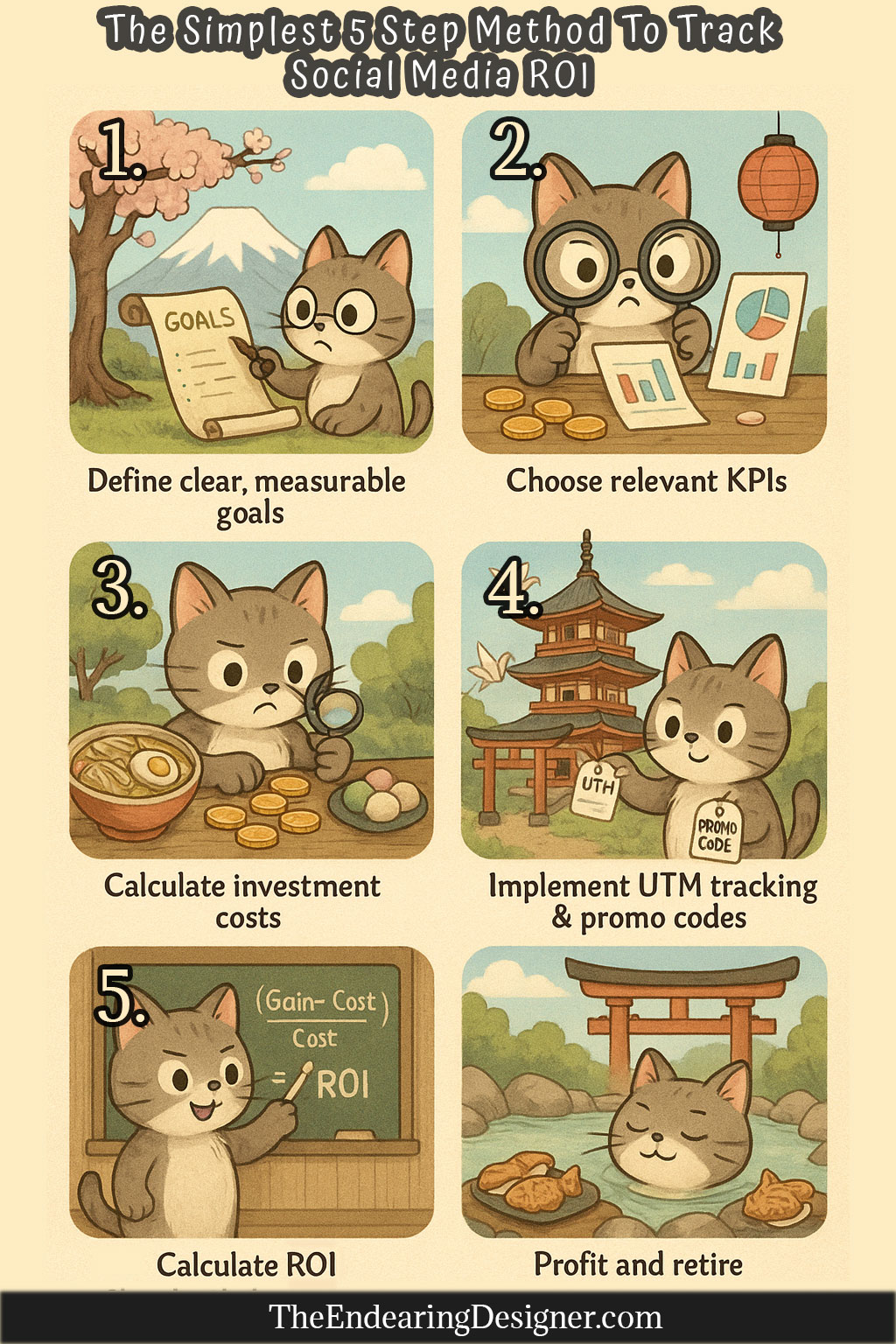
Social media marketing is vital for modern businesses, but many struggle with one crucial question: “Is our social media investment paying off?” If you’ve been searching for a straightforward way to measure your social media ROI without getting lost in complex analytics, this guide is for you.
What is Social Media ROI?

Social media ROI measures the value your business gets from investing time, money, and resources into social media marketing compared to what you put in. This value comes in various forms:
- Direct revenue from social media campaigns
- Lead generation and customer acquisition
- Website traffic increases
- Brand awareness growth
- Community building and engagement
Understanding your social media ROI helps determine if your strategies are working and where to focus your resources for maximum impact.
Why Tracking Social Media ROI Matters
Smarter decision-making: Know where to allocate your budget based on what’s actually working.
Accountability: Justify your social media investments to stakeholders with hard data.
Performance optimization: Identify your most successful content, campaigns, and platforms.
Resource allocation: Make informed decisions about where to spend your time and money.
Competitive advantage: Use data insights to refine strategies faster than competitors.
The Simplest Method for Tracking Social Media ROI
After analyzing various tracking methods, the most effective yet straightforward approach combines UTM parameters with Google Analytics for website traffic and online conversions, supplemented by unique promo codes for direct sales attribution.
Here’s how to implement this method in 5 simple steps:

Step 1: Define Clear, Measurable Goals
Start by establishing what you want to achieve with your social media efforts. Your goals should be SMART:
- Specific: “Increase website traffic from Instagram by 20%” rather than “Get more traffic”
- Measurable: Include numbers that can be tracked
- Achievable: Set realistic targets based on your resources
- Relevant: Align with broader business objectives
- Time-bound: Set a specific timeframe
Common measurable social media goals include:
- Generate X leads per month from social media
- Increase website traffic from social channels by X%
- Achieve X direct sales attributed to social media campaigns
- Grow follower count by X within a specific timeframe
- Improve engagement rate by X% over a defined period
Step 2: Identify Your Key Performance Indicators (KPIs)
Select KPIs that directly relate to your goals:
For brand awareness:
- Reach
- Impressions
- Follower growth rate
- Brand mentions
- Share of voice
For engagement:
- Likes and reactions
- Comments and replies
- Shares and retweets
- Click-through rate (CTR)
- Engagement rate
For website traffic:
- Website visits from social media
- Referral traffic
- Bounce rate of social traffic
- Average session duration
For lead generation:
- Number of leads from social media
- Conversion rate of social media leads
- Cost per lead (CPL)
- Lead quality
For sales conversions:
- Direct sales attributed to social media
- Conversion rate from social media traffic
- Revenue generated from campaigns
- Return on ad spend (ROAS)
Step 3: Calculate Your Investment Costs
Track all costs associated with your social media efforts:
- Advertising budgets for paid campaigns
- Content creation costs (photography, videography, copywriting)
- Staff time allocated to social media management
- Software and tool subscriptions
- Any other resources directly invested in social media
Be thorough here—accurate cost tracking is essential for true ROI calculation.
Step 4: Implement Simple Tracking Methods

For website traffic and conversions – UTM parameters + Google Analytics:
- Create unique UTM parameters for all links shared on social media using Google’s Campaign URL Builder or a similar tool
- Structure your UTMs consistently:
- utm_source = the platform (facebook, instagram, linkedin)
- utm_medium = the type of traffic (social, paid_social)
- utm_campaign = your specific campaign name
- utm_content = the specific post or ad
- Set up goals in Google Analytics to track conversions from social media traffic
- Create regular reports showing traffic and conversions from each social channel
For direct sales attribution – Unique promo codes:
- Create platform or campaign-specific promo codes (e.g., INSTA25, FB25)
- Share these unique codes in your social media content
- Track redemptions at checkout to directly attribute sales to specific platforms or campaigns
For broader impact – Platform analytics:
Use built-in analytics tools from each platform (Meta Business Suite, Instagram Insights, TikTok Analytics, etc.) to track engagement metrics and audience growth.
Step 5: Calculate Your ROI Using a Simple Formula

The fundamental formula for social media ROI is:
Social Media ROI = ((Value Generated - Cost of Investment) / Cost of Investment) × 100For example:
- If your e-commerce business generated $50,000 in sales from social media referrals
- And you spent $18,000 on social media marketing
- Your ROI would be (($50,000 – $18,000) / $18,000) × 100 = 178%
For B2B companies measuring lead value:
- If you generated 100 qualified leads valued at $200 each (total value: $20,000)
- And your social media costs were $4,000
- Your ROI would be (($20,000 – $4,000) / $4,000) × 100 = 400%
Real-World Success Stories
Galaxy Theatres: By implementing targeted Facebook and Instagram campaigns with proper tracking, they achieved a 72% increase in ticket sales and significantly grew their Instagram engagement.
Incontact: This B2B company trained their sales team on social selling techniques with careful ROI tracking, resulting in a 215% increase in revenue.
Retro Kids: The toy company lowered their cost per acquisition by 31% and increased their return on ad spend to 4.27 through strategic social media campaigns with proper attribution.
Key Takeaways for Simple, Effective ROI Tracking
- Focus on goals that matter to your business. Don’t try to track everything—concentrate on the metrics that directly impact your business objectives.
- Be consistent with your tracking methods. Use the same UTM structure and tracking processes every time to ensure accurate data.
- Combine quantitative and qualitative data. Numbers tell only part of the story—customer feedback and sentiment are also valuable.
- Start simple and build complexity over time. Begin with the basic tracking methods outlined here, then add sophistication as you become more comfortable.
- Review and optimize regularly. Check your social media performance data at least monthly and adjust your strategy based on what’s working.
By following these straightforward steps, any business can effectively track their social media ROI without getting overwhelmed by complex analytics or expensive tools. The key is consistency in tracking and a focus on the metrics that directly connect to your business goals.
Remember: The goal isn’t perfect attribution, but rather a consistent framework that helps you make better decisions about your social media investments.
This article (https://theendearingdesigner.com/simplest-way-to-track-social-media-marketing-roi) was first published on The Endearing Designer.






